You may have heard about the recent Apple watch ban that was implemented by the International Trade Commission (ITC) in late November. This is just one development in a years-long legal battle between the tech industry giant and the medical device company, Masimo. The decision was predicated on the ITC’s finding that Apple had infringed upon Masimo’s patented pulse oximetry (SpO2) technology – the two companies have been in a tit-for-tat legal dispute over various claims to patent infringements for a few years now. Though the ban was upheld by the Biden administration, a federal appeals court has temporarily suspended it, allowing for the continued importation of Apple watches with the technology in question into the United States.
Despite the legal drama, several weeks after the ITC’s decision, an announcement was released for the first FDA-approved smartwatch in the United States – Masimo’s W1 Medical Watch. With the FDA’s approval, Masimo’s watch is available for over-the counter and prescription use for both consumers and patients. The wearable medical device, which provides continuous, real-time oxygen saturation (SpO2), heart rate (HR), and pulse rate (PR) readings, can be used by adults in multiple clinical settings, as well as at home. Additional features include perfusion index (Pi), hydration status, and step count. According to Masimo Founder and CEO, Joe Kiani, the device has already been implemented in several European and Middle Eastern hospitals to improve virtual health programs and perioperative care. This could have significant impact on clinical care worldwide, as well as on the smartwatch industry.
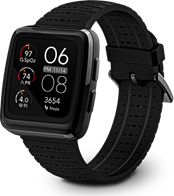
Masimo W1 Medical Watch (Masimo)
Since the COVID-19 pandemic, there has been increased demand by consumers for over-the-counter, at-home pulse oximeters for self-assessment of respiratory status. However, with little standardization of these devices and their technology and software, there are many being sold that lack reliability. In 2021, the FDA released a Safety Communication regarding the accuracy and limitations of at-home pulse oximeters in an attempt to guard consumers from flawed and potentially life-threating information. The safety communication is an evolving educational tool that offers relevant background on how pulse oximeters work, how they are studied against the gold standard of arterial blood sampling for oxygen saturation measurement, and the criteria that any approved, prescription medical device must undergo to receive such a standing with the FDA.
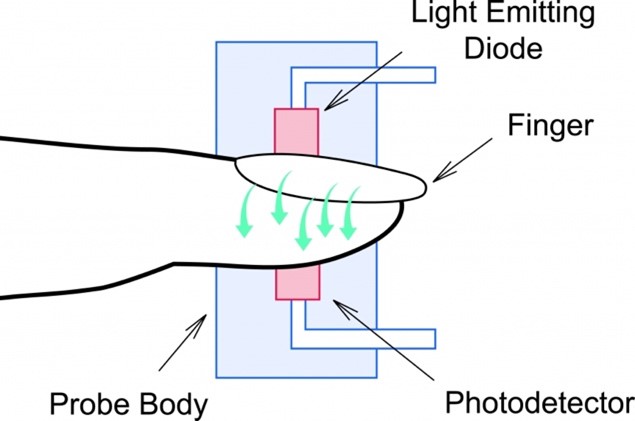
Illustration of how a pulse oximeter works: At the top, the light emitting diode sends red and infrared rays through the finger to a photodector below. The detector then measures the amount of light that is absorbed as it passes through the finger. (Youngzine)
In its simplest form, pulse oximetry is a non-invasive tool that uses sensors to measure and calculate ratios of absorption of red and infrared light by oxygenated and deoxygenated blood. Using software algorithms, an estimate of arterial oxygen saturation (SaO2) is generated from these readings. However, the sensor measurements can easily be affected by external light, motion, skin temperature, poor perfusion, skin tone, and nail polish. This extraneous information alters the accuracy of SpO2 readings. In general, the accuracy of SpO2 readings is highest at or above 90%, less accurate from 80-90%, and least accurate with readings below 80%. Despite these flaws, it is a useful clinical tool for alerting providers to a patient’s oxygenation trend and thus when intervention or more invasive methods of evaluation may be necessary. Because newer smartwatches that provide SpO2 and HR readings rely on the same pulse-sensing technology, these same limitations are carried over to watches. The advanced data that is generated by these devices is then calculated by algorithms from pulse ox measurements. Thus, like pulse oximeters, not all smartwatches and activity-tracking devices are created equal, and their lack of standardization of sensor technology, software processing, and algorithms leads to the same unreliability of data provided to the user by these devices.
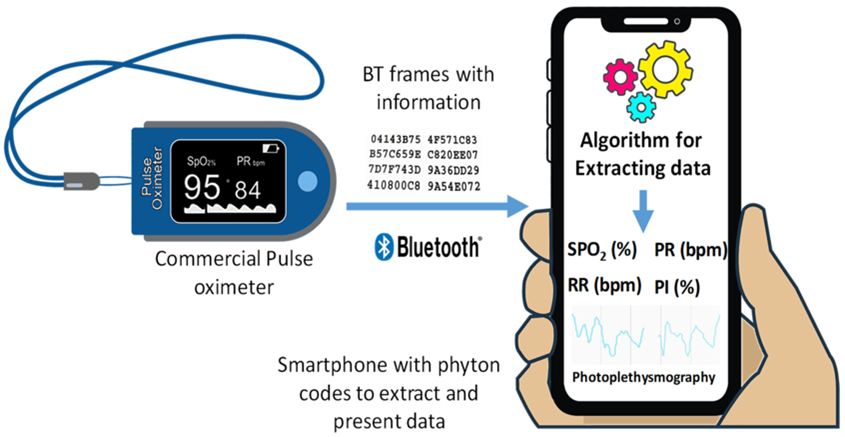
Modern pulse oximeters and smartwatches offer connectivity to cellular apps which summarize data from their measurements. (MDPI)
Enter Masimo. With over 30 years of research and design of SpO2 technology (the same technology Masimo is claiming to have been copied by Apple), the medical device company purports to have the most reliable pulse oximeters. Over this time, the company has developed and refined its sensors, hardware, and algorithms that process the signals – trademarked Signal Extraction Technology (SET). This finely-honed software works to filter out noise from extraneous motion, low perfusion states, and other inherent flaws of standard pulse oximetry. In multiple clinical settings, Masimo is accepted to be the standard for SpO2 monitoring. Undoubtedly, the Masimo watch now offers the most trustworthy, medical grade data of any smartwatch on the market.
Despite this fact, the Masimo W1 is unlikely to make its way onto the list of options for amateur athletes or outdoor enthusiasts any time soon. For these folks, the choices are many when it comes to smartwatches. Noteworthy brands include Garmin, Apple, Casio, Suunto, and others. The most appealing features to most who venture off grid include GPS tracking, an altimeter, barometer, and compass – the so-called “ABCs”. Various brands also include health and activity tracking like HR, energy expenditure (calorie count), and step count. There are also newer models with more advanced calculations, such as maximal oxygen consumption (V̇O2 max), heart rate variability (HRV; an indicator of overall training stress), hydration, and sleep quality and recovery. While these features can be great for following trends with any given activity or recovery plan implemented for athletes or adventurers, the data is only as good as the technology within the device. Based on comparison to the gold standards of more advanced sports physiology measurements, such as chest strap measurements for HR and HRV and cardiopulmonary exercise testing for V̇O2 max, experts put little stock into the absolute values of some of these smartwatch readings. Despite this, there is still potential for some useful applications of these devices in wilderness medicine, such as smartwatch-estimated V̇O2 max as a predictor for susceptibility to Acute Mountain Sickness.
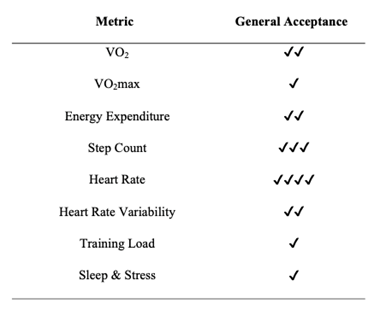
Consensus expert opinion on the relative acceptance of physioliogic metrics provided by smartwatches. 1 = not generally accepted. 4 = widely accepted. (Pubmed)
As a Garmin smartwatch user myself, I have at times questioned the gobs of data that I am receiving from my watch. Though the overnight oxygenation readings, sleep quality measurements, HRV, and training status features are alluring, I don’t always agree that I feel the way my watch suggests I might from a training or sleep standpoint. Its trends match up with what I would expect – after a long call shift with over 16 hours of work and only a short overnight nap, it suggests that I will have below average levels of energy and that I need to rest. But after a 5K jog during which my heart rate exceeded 160 for more than 15 minutes, it suggests I allow myself to recover for 70+ hours – not a feasible recovery plan if someone is training for a more strenuous activity such as a marathon or alpine trek. I found similar limitations with an early-generation Apple watch. Though I may not use the Masimo W1 exclusively, I would be interested in a head-to-head comparison of the Masimo, especially living at and traveling to altitude.
Though the Masimo W1 watch may never take over the smartwatch market, its presence will hopefully lead to improvement in the quality and reliability of watches as they continue to develop. The industry has already seen significant growth over the last several years and is predicted to see almost 20% additional growth through 2026. Perhaps the holy grail of smartwatches would be one that features GPS, altimeter, barometer, and compass functionality, along with medically reliable health-tracking data regarding oxygenation (particularly at altitude), HR, hydration status, perfusion index, HRV, and V̇O2 max. The added emergency SOS satellite feature included in the Apple watch would be the cherry on top.
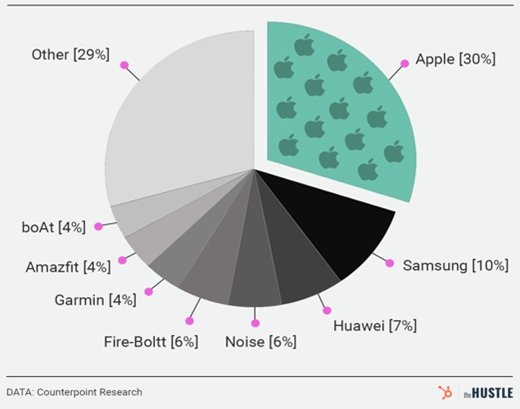
Global smartwatch market share by shipment volume. (Hustle)
For now, Apple continues to dominate the smartwatch industry. Time will tell if Masimo’s legal pursuits will have any overall effect on this or if they will cut their own slice into the market. The announcement of the W1 Medical Watch is quite exciting for the medical community and patients with chronic conditions. Hopefully it will also have a larger impact on the quality of wearable devices.